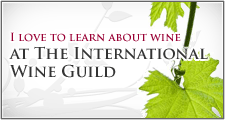What the heck are you talking about?
So in the interest of trying to assure that you do know what we’re talking about when we describe wines, I present here a primer on just that. Originally intended to be just a few words of briefly defined concepts, the thing ballooned in size, expanding each time I thought of yet another descriptor that needed elucidation, and now we’ve had to break the piece into multiple parts. In this article we’ll cover appearance.
This is still by no means comprehensive. Admittedly, some of my definitions may not be as lucid or straightforward as you might wish, but hopefully it will shed enough light on the subject for you to get a grasp of what we’re talking about when we’re talking about wine.
The three major aspects of wine that we look at when tasting are appearance, aroma/flavor, and structure/texture. The simplest to explain is appearance, so let’s start there.
Appearance When describing color, most wine writers tend to be mercifully prosaic. Ruby, garnet, straw, green-gold, and so forth; we write what we see, and there’s rarely more to it than that.
The rim – Sometimes you may encounter a reference to how the wine looks at the rim, which can be confusing if you don’t know what that is or why anyone should care about it. This is the edge of the wine’s surface, where comes into contact with your wine glass, and it can be somewhat telling about the wine itself. Wines lose density as their tannins and other pigments oxidize over time and fall out of solution (resulting in sediment in the bottom of the bottle). A wine like this will usually reveal a thin, clear band at the rim, since the wine’s water is attracted to the glass more than the pigments and other components. Young wines and very concentrated wines will show the pigment going all the way up to the rim. Looking at the rim really won’t reveal any information about the wine that you couldn’t obtain through tasting, however, so you rarely see it mentioned by writers. Sometimes, though, a mature, older wine will surprise a critic by still showing color all the way up to the rim, suggesting that the wine is still seamlessly concentrated, even after x-number of years in the cellar. And that’s when a writer can’t help but comment.
Bright (color)– In reference to wine color, brightness is used in the everyday sense.
Bright (light)– The term is often used, though, to describe how the wine reflects light or refracts light that passes through it. Wines that seem to visually sparkle are referred to as bright, regardless of how bright their color may be. This is considered to be a good thing, especially since the opposite of brightness is dullness, which is generally an undesirable attribute in any context.
Clarity/Turbidity– Even wines that are so dense as to be opaque should still be clear, at least in the sense that they’re not cloudy. It’s important to understand that there’s a difference between cloudy wines and wines that have sediment. Sediment is the result of tannins that have precipitated out of solution; some young wines and most older ones will ‘throw’ sediment. Given a chance to rest upright, the wine’s sediment will collect at the bottom of the bottle. Turbid wines stay cloudy no matter how long they rest.
Oxidized– When the pigments in a red wine go to brick or brown, and when a white wine goes to amber, it’s a sign of oxidization and can be an indication that the wine is over the hill. But oxidized color is not necessarily a bad thing in a fully mature wine and should be expected with age. Oxidization also affects a wine’s flavor, which we’ll get to later.








